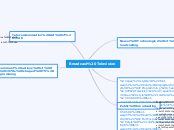Broadcast Television
Newer Technologies of broadcasting
1946: Mechanical color system, black-and-white sets on the market by mid-1946
1947: CBS's color system would be a hardship on set owners to buy new sets
1948: Tv emerged as a mass medium (number of stations, sets, and audiences all grew more than 4000 percent within one year)
The network programming was broadcast through local stations.
In the late 1940s, when most cities had only one or two TV stations (CBS and NBC)
Programming changes of Television (in the last 20 years)
Reality TV: the genre came to the fore in the 1990s with actual events or some which were bizarre
Big jump in popularity in the summer 2000
NEW GENRE : Music became popular in the drama genre in 2009
Public broadcasting
because they can advertise
more money to produce these shows
Giving permanent funding
Telecommunication Act of 1996
V-chip: The main TV sets equipment
Must-carry: another law that had an important effect on broadcast TV
Retransmission content
Government actions of the 1970s shaped TV programming
1970s: great effect on broadcast TV
Public TV: finds it hard to produce material that will catch the fancy of audience members
NIXON: The organization for public broadcasting set up in 1967
FIN-SYN: (Financial interest-domestic syndication) was adopted because the FCC thought the networks, which at the time had about 90 percent of the prime-time audience.
PTAR: (Prime Time Access Rule) In 1971, The FCC established the PTAR. The purpose was to break the networks monopoly on programming
Family Hour: began in 1975
